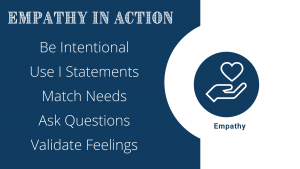TL;DR:
- Our learners’ behavior is an important form of communication.
- Consider and revise your responses to student behavior to be more empathetic.
- Don’t assume how a learner is feeling; ask them directly.
- Validate your students’ feelings to ensure they feel heard and understood.
During my first year teaching, I spent countless hours learning, planning, and creating. I loved every second of it, despite how long everything seemed to take me. I believe everything took so long partly because it was a new experience, and partly because everything needed to be color-coded and perfect. Come on…I know some of you know exactly what I am talking about!
A few weeks into the school year, I noticed Sally was consistently not completing her homework. You know what felt worse? She didn’t seem to care! Didn’t she know how hard I worked preparing? I felt frustrated and took it personally. Imagine. I actually believed that scenario was about me. I was focused on me, the teacher, rather than Sally, the learner.
Discovering Sally’s hidden story taught me a valuable lesson. I learned to teach with empathy.
Putting Empathy to Action

In my first #TeachEmpathy blog series post, I discussed the power of empathy. Empathy has the ability to move us towards deeper, more meaningful relationships. This is critical in the classroom. An empathetic teacher has the ability to enhance learning. As James Comer said, “No significant learning can occur without a significant relationship.”
But how does it work? What does empathy look like within the classroom?
Validation does not mean agreeing or even approving. Acceptance truly strengthens relationships while maintaining and respecting different opinions. Click To TweetEmpathetic Teacher: Be Intentional
When our learners are unable to verbally express how they are feeling, they may utilize their behavior as a form of expression. Most times the story behind the behavior will break your heart, not make you frustrated. Our learners’ behavior is an important form of communication.
We are human, and it is not always easy to respond to every situation with empathy. Being an intentional empathetic teacher involves considering how our choices impact our learners. This awareness and purposeful teaching behavior will help us to identify the best interaction for our learners’ needs.
Empathetic Teacher: Use I Statements
Speaking without empathy may sound like:
“If you’re going to keep yelling at your friends, you’re going to miss recess!”
This response doesn’t recognize the emotion behind the behavior or seek to understand the hidden story. When learners hear that, they will not likely be motivated to reflect and express how they are feeling differently.
Imagine how our learners might feel with an empathetic response:
“I know we’ve talked about yelling at friends. I also know you know it’s not the best way to handle what’s bothering you. Is there more that I need to understand so I can help?”
Empathetic Teacher: Match Their Needs
As educators, we are always seeking best practices. It is critical that we recognize that what is best practice for one learner may look different for another learner. We must focus on understanding what learners need from us instead of what we think they need. Don’t assume to know how a learner is feeling. It’s important to ask directly.
Empathetic Teacher: Ask Questions
Open-ended questions are an invitation to more conversation. Learners need the opportunity to share in a safe space without judgment. Below are some great examples to try.
- What makes a good friend?
- Is there something about today that’s been hard for you?
- How exactly did the fight start?
- Who would you like to get to know better at school?
- Tell me about someone who made you feel special. What did they do?
- Which of your friends do you admire? Why?
- What do you wish we knew about you?
Empathetic Teacher: Validate Feelings
Validation means understanding another’s perspective and being supportive of their feelings. It means truly listening and helping someone to feel heard and understood. Above all, it helps someone feel accepted. Validation does not mean agreeing or even approving. Acceptance truly strengthens relationships while maintaining and respecting different opinions.
Validating statements:
- Thank you for sharing that with me.
- It is ok to feel that way.
- I understand how the situation made you feel like that.
- I see it is hurting you.
- I’m here with you.
Invalidating statements:
- It could be worse.
- You’ll be fine.
- It’s not a big deal.
- Don’t be so sensitive.
- It is a waste of time worrying about this.
Try It!
I invite you to get into the experience with your learners! Discover their hidden stories behind their behaviors. It is amazingly connecting!
Please click here to connect more…I would love to hear your feedback, questions, and how you teach with empathy!
About Sari Goldberg McKeown
Sari Goldberg McKeown is a lifelong learner. She believes education is about who we teach, not just about what we teach. Sari is passionate about culture, relationships, and learning from each other. She believes in the power of being a connected educator. As educators, we are better together! Sari has served as an educator in many K-12 roles for over fifteen years, including classroom teacher, literacy specialist, mentor, supervisor, and coordinator. Currently, Sari serves as a central office administrator and remote learning principal on Long Island, New York.
She is the co-founder and co-moderator of the #Read2Lead Twitter chat and Voxer group, co-founder of #UnitedWeLearn, and series contributor on the #MentorRoundTable webinar series. She is also honored to be a part of the EdCamp Long Island planning team. Currently, Sari is a doctoral student in the Ed.D. Educational Administration and Supervision program at St. John’s University. Sari is a proud wife to third grade teacher, Bob, and bonus mom to three amazing children.




